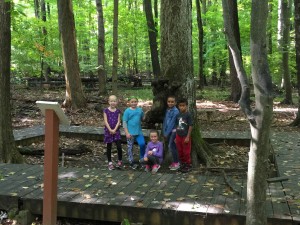Superintendent lists several options to ‘right-size’ district
By Jim Newell
Review Staff Writer
The Lake Orion school district has known for some time it would need to take steps to cut costs and realign the district to fit the expected student population, and on Sept. 28 the administration executive team recommended closing Webber Elementary as part of the remedy.
Superintendent Marion Ginopolis presented the recommendations to the school board along with recommendation to sell
Ginopolis and the executive team – assistant superintendents Heidi Mercer, John Fitzgerald and Rick Arnett – recommended closing Webber because the district could see as much as $4 million for the sale of the 38-acre complex, which includes the Moose Tree Nature Center.
That area is zoned single-family residential and could also bring the district as many as 40 students once the land is developed.
Ginopolis added that it costs about $500,000 annually to operate Webber Elementary, and that Moose Tree’s operating costs are $50,000 each year. Webber also has the highest critical needs for repairs, about $2.6 million.
“It’s really a prime piece of property for resale,” Ginopolis said.
The district’s current elementary pupil count is 3,275, but the buildings have capacity for 4,082 students. If the district closes one school, the district would still have capacity to grow at the elementary level.
If the board decides against closing Webber at an upcoming meeting, an alternative recommendation was to close Pine Tree Elementary, which has land for new housing development and could yield
Pine Tree also has a high repair cost, estimated at more than $2.1 million over the next six years.
Ginopolis said the administrators did not recommend closing two schools because a second closure would have put the remaining elementary buildings at capacity.
Ginopolis also discounted the possibility of putting fifth grade students in the middle school. “That makes no sense to me. I’m not crazy about fifth grade students going into the middle schools. I believe there is a real difference between fifth grade students” and the older middle school students, she said.
While there is room for growth in the middle schools, Ginopolis said that the configuration of the middle schools around the district would be burdensome if one closed. And the underutilization of the middle schools gives the district options.
“I think (closing a middle school) is really too aggressive,” Ginopolis said. “And it gives the district flexibility down the line, and now.”
Schoolboard President Scott Taylor said he doesn’t want to close two schools now and then if there is growth in the district, to have to go to the public and ask for bond money to build a new school.
The administrators also recommended discontinuing a separate multi-age school and the focus school strategy because it contains additional costs. Ginopolis said all the district’s elementary schools teach the same curriculum and one is not better than another.
“Quite frankly, I really do believe that we meet the needs of our students at all of our schools,” Ginopolis said.
If the district does eliminate the focus schools, the district could save $230,000 – $306,000 per year on reduced busing.
The administration also recommended continuing the balanced calendar year (year-round) program but moving it to Orion Oaks. Carpenter Elementary would become a regular school calendar elementary.
“There’s not one particular school that is outperforming another school,” said Heidi Mercer, assistant superintendent of teaching and learning. “If you truly look at the data, the numbers are really not that far apart.”
Other recommendations included:
· Redistricting the student population for greater balance in the elementary buildings.
· Selling the district-owned property at Clarkston/Adams roads, which could bring in $2.1 million and additional money if the land is developed and families move in.
· If feasible, selling or leasing the administration building once the district has been redistricted.
· Continue to offer schools of choice in grades K-8 for non-resident students, if the space is available, and not to exceed 10 percent of the student population.
· Temporarily discontinue the intra-district open enrollment until the new landscape of the district has been set and administrators can determine available space in facilities.
“We have to downsize our district and look at ways to get additional revenue,” Ginopolis said.
Ginopolis said she doesn’t anticipate laying off any teachers if the district closes a school because the district will still have the same number of students. “We would have one less administrator in the district,” she said.
“I think we’ve seen the worst of it in this area,” said Rick Arnett, assistant superintendent of human resources, to questions from the board on why the administrators did not recommend closing two schools, adding that enrollment is expected to level out. “We’re not a deficit district, we’re not forced to make drastic decisions at this time.”
“I think we pay too much attention to this notion that redistricting is a negative thing for our district,” Arnett said.
The desired tentative timeline for the school board to make its decisions is:
· Oct. 12: should the district close a school, how many, at which levels and should the district continue to accept schools of choice (capped at 10 percent)?
· Nov. 16: if the district closes a school(s), which schools should be considered for closure based on the facility needs of that building as well as capacity?
The school board next meets at the Administration Building on Lapeer Street at 7 p.m. Oct. 12.


The Moose Tree Nature preserve is not a “prime piece of property for resale.” It is a unique wild space of wetland and forest that was donated for all future Lake Orion students to enjoy. The one million dollar nature center was built in 2000 with bond dollars. With the support of the sinking fund, the district has the funding for repairs and to preserve this resource for generations to come.